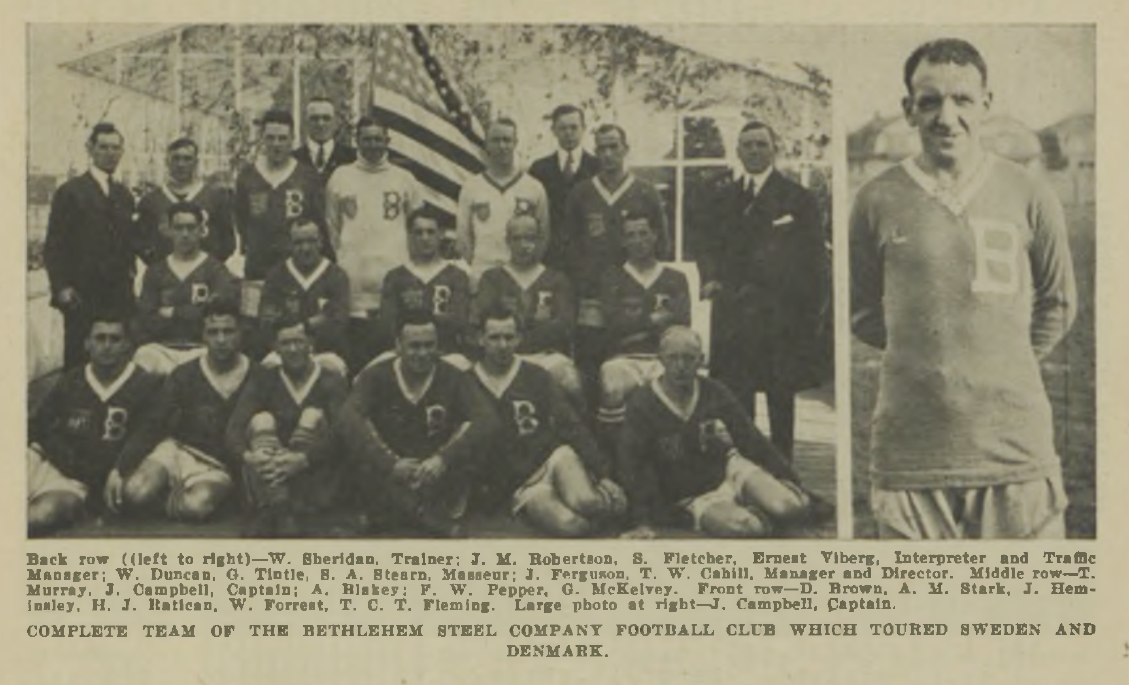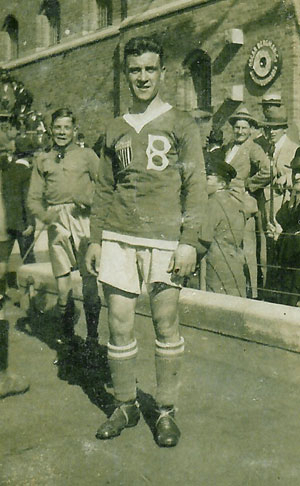
That Bethlehem Steel FC was chosen to play a series of games in Sweden and Denmark in August and September 1919 is readily understandable. Months before, the team captured three championships: the first of an eventual three National Association Football League titles, the fifth of six American Cups lofted during the team’s history and the fourth of what would be five National Challenge Cup championships. The team also had international experience. In November 1918 Bethlehem defeated an All-Canada side 4-1 in Harrison, New Jersey before traveling to Toronto to face All-Canada again, winning 2-0 on December 1. Reports on the team’s return to Canada for another series of matches in May 1919 coincided with the announcement of the Scandinavian tour.

Seventeen players boarded the Swedish-American Line steamship Stockholm in New York on July 23 for the transatlantic trip, six of whom were guest players. Two goalkeepers were on the team, Bethlehem’s William Duncan and George Tintle, who had been with the All-American team in 1916 and recently returned from service in France. Three Bethlehem full-backs — John Ferguson, Samuel Fletcher, and James Wilson — were joined by James Robertson, captain of the Robins Dry Dock team, and another veteran of the 1916 tour. Three Bethlehem halfbacks — team captain James Campbell, 1916 veteran Thomas Murray, and Frederick Pepper — were joined by two other veterans of the 1916 tour, Philadelphia native Albert Blakey, himself recently back from Army service, and Newark’s Robert “Rabbit” Heminsley, most recently of the Merchants’ Shipbuilding Team “A.” Bethlehem forwards Thomas “Whitey” Fleming, William Forrest, George McKelvey, and Harry Ratican were joined by Paterson FC’s David Brown and Archie Stark.
Roger Allaway writes in Corner Offices & Corner Kicks that the inclusion of Stark and Brown “enabled Bethlehem Steel to field a forward line twice in the 14-game tour that included four future Hall of Famers, Stark, Brown, Harry Ratican and Whitey Fleming. That may have been the most powerful group of forwards ever to play for the same club team in American soccer history.” Thomas Cahill, Honorary Secretary of the USFA and manager of the 1916 tour, was named team manager for the Scandinavian tour while William Sheridan, the man who had just led Bethlehem to three championships, was named team trainer.
The 1919-20 Spalding Guide describes a marked contrast to the departure of the US team three years before when few were present to send off the national team. Now, a “large crowd of soccer officials and fans and relatives and friends of the members of the Bethlehem party saw them off on their journey.” If expectations had been low for the US team in 1916, the opposite was true for Bethlehem Steel FC in 1919. “If America’s championship socker football club, Bethlehem’s Steel Company’s great team, fails in its conquest on foreign fields in the next three months,” wrote the Philadelphia Inquirer on July 25, “it will have no excuses to offer.”
AIK 2-2 Bethlehem Steel
The team undertook a vigorous training program during the voyage, arriving in Gothenburg on August 4. Departing that night by train for Stockholm, training continued before the first match of the tour against Allmänna Idrottsklubben (AIK). The team also enjoyed time for sightseeing, including watching AIK defeat Jarva 5-2 on August 6.
Some 20,000 spectators filled Stockholm Stadium on August 10 for the opening match and they did not have to wait long for the scoring to begin. “A few seconds after the start,” the official tour report in the 1919-20 Spalding Guide describes, “Pepper got hold of the ball and passed over to Fleming, who carried it down the line and centered finely to Stark, who headed the ball into the net. The goal was accomplished in less than one minute from the kick-off, and the score stung the Swedes.” But despite repeated attacks no more goals were scored in the first half.
Twenty minutes after the start of the second half, AIK leveled the scoreline “when Bergstrom, the Swedes outside right, shot past Duncan for the equalizing goal.” Bethlehem responded with repeated attacks on AIK’s goal. Then, Forrest put the visitors ahead after a corner kick from McKelvey. But the home team was not to be denied and ten minutes after Bethlehem took the lead, “their wonderful outside right again took a pass and shot at a right angle into goal for the tieing score.”
Fleming was widely acclaimed as the best player on the Bethlehem side, with the two backs, Wilson and Ferguson also praised. Still, the draw was something of a disappointment for Swedish football fans, who apparently expected to see a style of play more representative of a team from a Scottish league. O. Soderlund, a reporter for Stockholm’s Tulningen newspaper, wrote that “the Americans did not live up to expectations and it was surprising because nine of the players are Scottish and of them could be expected more than of real Americans.” Soderlund added, “But it seems that even football playing gets Americanized after a short time in the United States. Perhaps they were handling the ball a little better than the American Team of 1916, but the same system was leading among them. Some of these players have not become American citizens yet, but they are indeed playing American football.”

The newspaper Dagens Nyheter agreed: “Some people say the Americans were not living up to expectations because they did not beat A.I.K. It is right: this first game they did not show much of Scottish football, which we had hoped to see. The forward line, for instance, very seldom kept together well, and the halfback did not work out properly very often, and especially Rattican was not at his best for the day.” Still, Dagens Nyheter noted “the speed was better than we have seen in that stadium for a long time, without letting up for a moment,” adding, “we must remember that the Americans played their first game on foreign soil, on a new field and for a new public, which of course is locally patriotic. During the first half, they were very nervous and it could also be seen during the second half.”
Swedish Provinces 1-2 Bethlehem Steel
Three days later, Bethlehem faced Stockholm Tigrarna, the team the All-Americans had played to a 1-1 draw in the opening match of the 1916 tour, in front of 17,000 spectators at Stockholm Olympic Stadium. While the Spalding Guide reports Bethlehem’s performance “was about on par” with their opening match, the team’s pace “surprised the Swedes” and the visitors earned the first victory of the tour with a 1-0 win. On August 17, Bethlehem faced a side made up of “the pick of the Swedish provinces.” A crowd of 15,000 saw the tourists open the scoring when the Swedish keeper parried a shot from McKelvey into the path of Forrest, “whose unerring toe spun the ball into the net.” The provincial side soon equalized from a headed goal following a corner kick and the teams were level at 1-1 at the half. Ten minutes after the resumption of play, Fleming crossed to McKelvey, who headed in the go-ahead goal. Despite repeated attacks, the Swedes were unable to score and Bethlehem finished with their second win of the tour.

When the tour concluded on September 24, 1919, with a 0-0 draw against Hammarby, Bethlehem had played an average of one match every three days over the 45 days since the tour began against AIK on August 10. No excuses needed to be made, the team had won seven games, drawn five, and lost only two, outscoring their opponents 22 goals to 14. Total attendance for the tour was approximately 154,000 and among those who had attended were the King of Sweden, Gustaf V, the Swedish Crown Prince Gustaf Adolf, as well as Christian X, the King of Denmark. The team also found time to play three baseball games against Swedish sides, winning each game. While expenses for the tour were about $45,000 — around $700,000 in today’s value — the tour finished in the black. Before the team departed for home they were presented with a $3,500 bonus — about $55,000 today — by the Swedish football authorities.
“It was but another fine example of the excellent sportsmanship and generosity of our Scandinavian friends,” concluded the official tour report.
For photos from the tour see the William Sheridan collection at www.BethlehemSteelSoccer.org
Sources
Allaway, Roger. Corner Offices & Corner Kicks. Haworth: St. Johann Press, 2009.
Farnsworth, Ed. “Bethlehem Steel FC’s 1919 tour of Scandinavia.” The Society for American Soccer History. Accessed September 23, 2020. https://www.ussoccerhistory.org/bethlehem-steel-fcs-1919-tour-of-scandinavia/
Rex. “American Champions’ Tour of Sweden and Denmark.” Spaldings Official “Soccer” Football Guide, 1919-20, ed. Thomas W. Cahill (New York, American Sports Publishing Company), 25-61.
“Bethlehem Soccer Team Will Play At Falls Sunday,” Buffalo Enquirer, May 23, 1919, 16.
“Soccer Team Wins Two Games,” The Globe (Bethlehem), May 26, 1919.
“Bethlehem Beat Toronto,” Ottawa Citizen, May 26, 1919, 14.
“Bill Baggs Will Play for Merchants,” Philadelphia Inquirer, July 25, 1919, 12.

Pingback: Stars and Stripes Soccer on the Silver Screen before 1930 – Society for American Soccer History